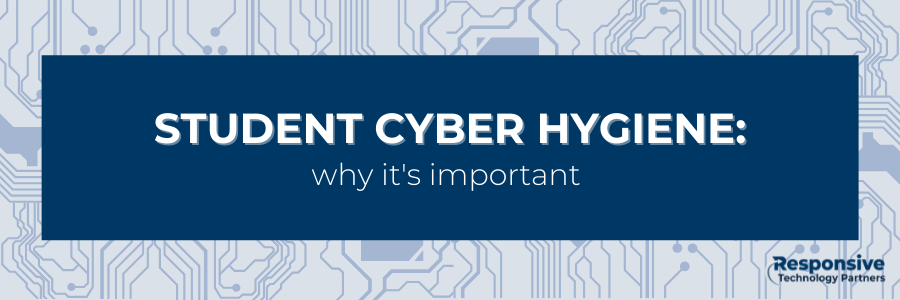
COVID-19 cases among children are rising, accounting for about a quarter of total cases due to the new delta variant, according to the University of Minnesota Center for Infectious Disease Research and Policy.
This uptick in student COVID-19 cases causes the future of educational instruction to remain up in the air. With COVID-19 cases rising among students and schooling becoming increasingly online, it’s important for parents and teachers to be vigilant about monitoring students’ cyber activity to prevent catastrophe.
With some students being on school devices, it is essential that students understand "cyber-hygiene". Cyber hygiene is the set of principles for online behavior that prevents your cyber security from being breached.
“Cyber hygiene refers to fundamental cybersecurity best practices that an organization’s security practitioners and users can undertake. As you have personal hygiene practices to maintain your own health, cyber hygiene best practices help protect the health of your organization’s network and assets.” (RedSeal).
A lack of cyber-hygiene could be detrimental to students’ safety, as well as the security of the school system as a whole.
“If your child doesn’t understand basic cyber-security principles like not clicking on links if you don’t know where it leads, they could accidentally be the way a cyber-criminal gets access to the school system, no one wants that,” says Gray Analytics Business Operations Vice President Jennifer Elwell. (News19).
A lack of Cyber Hygiene increases the risk of a cyber-attack. According to Stealth Labs, education was one of the most vulnerable sectors for cyber-attack, making up almost 64% of all malware attacks, proving that there is a need for improved cyber-hygiene in education. Thirty percent of users in education were victims of phishing, a kind of cyber-attack where cyber-criminals pose as reputable companies to steal information such as usernames and passwords. (StealthLabs).
“The sudden shift to remote learning triggered by the pandemic has further deteriorated the situation. With students increasingly using their personal computers and unsecured networks to join online classes, the threat vector of the education sector is proliferating.” (StealthLabs).
If your student is not aware of basic cyber-hygiene and connects to an unsecure network, shares their password or username, or does not verify people’s identities, they could become victim to a multitude of cyber-attacks.
“‘As our children get back into extracurricular activities, they may be taking their device with them to do homework at the gym or at dance. Make sure your child only accesses the internet through Wi-Fi that is password-protected,’ says Elwell. ‘Once (a cyber-criminal) gets onto a child’s device that’s on your network then they can penetrate the other devices on your network which very well could be your work computer,’ says Elwell. Students need to change their passwords often, verify people’s online identity and avoid connecting to unsecured WIFI networks.” (News 19).
According to Berkeley Extension, teachers should be educating themselves and their students about malicious cyber activities to avoid becoming victim to these types of schemes.
“As a teacher, staying informed and learning the best practices to protect yourself and your students is always the best first step to take in cyber-security.”
Some topics teachers and parents should begin to introduce to their students are listed below. (Berkeley Extension).
- Data theft- “According to CNBC, cyber attackers know that students often have little understanding of how to properly guard personal and financial data being input online, typically for the first time. Experts say hackers can use this data for identity theft, credit fraud and more.”
- Mobile Malware- “Researchers at Check Point found that attacks targeting mobile devices have risen by 50% since 2018. With more students moving from a desktop or laptop to smartphone use, it is more important than ever to take mobile security seriously.”
- Malicious Social Media Messaging- “According to a study on cyber-security threats amid the COVID-19 pandemic, hackers are taking advantage of platforms such as Facebook and WhatsApp with scams to lure victims to phishing websites, which can compromise personal information.”
- Camfecting- “Many students today have a desktop webcam or camera built into their phone, tablet or laptop. Unfortunately, this can open the door to camfecting, where hackers are able to remotely access and take control of a webcam.”
- Social Engineering- “Social engineering scams are among the top cyber-security threats faced by higher education students, according to EducationDive. These attacks rely on manipulating users into revealing confidential information.”
Sources:
Neal, Madison. “Cyber-security company urges parents to monitor students use of technology”. News 19. 3 Sept. 2021 https://whnt.com/news/cyber-security-company-urges-parents-to-monitor-students-use-of-technology/
Admin. “Cybersecurity in Education: 10 Important Facts and Statistics.” Stealthlabs, 1 June 2021, www.stealthlabs.com/blog/cybersecurity-in-education-10-important-facts-and-statistics.
Quarrie, Nathaniel. “Cybersecurity in Education: What Teachers, Parents and Students Should Know.” Berkeley Boot Camps, 3 Sept. 2020, bootcamp.berkeley.edu/blog/cybersecurity-in-education-what-teachers-parents-and-students-should-know/#cybersecurity-for-students.
Soucheray, Stephanie. “US Data Show Child COVID-19 Cases Rising Exponentially.” CIDRAP, 8 Sept. 2021, www.cidrap.umn.edu/news-perspective/2021/09/us-data-show-child-covid-19-cases-rising-exponentially.
RedSeal. “What Is Cyber Hygiene | Cybersecurity Hygiene Definition and Cyber Hygiene Best Practices.” RedSeal, 8 Sept. 2021, www.redseal.net/cyber-hygiene.




